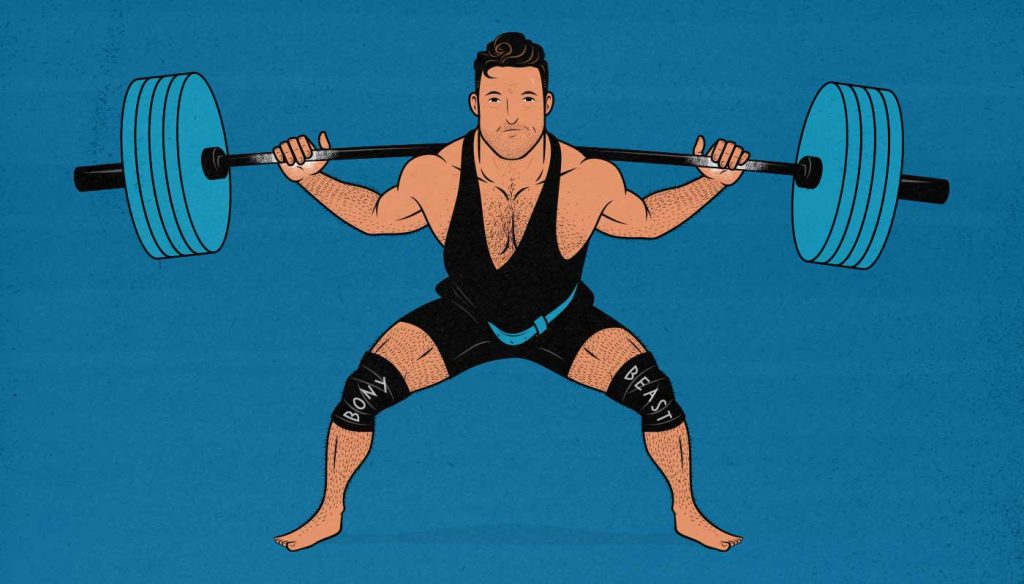
Is Strength Training Good for Building Muscle?
Is strength training good for building muscle? Some of the most popular programs that skinny guys use to bulk up, such as StrongLifts 5×5 and Starting Strength, are designed for gaining strength. But what if we’re trying to become bigger and stronger? Are strength training programs good for building muscle?
If we look at a recent study comparing low-rep training strength training against moderate-rep hypertrophy training, we see that hypertrophy training stimulates more than twice as much muscle growth per set. Does that show that hypertrophy training is better for building muscle?
There’s new research coming out showing that doing metabolic training in higher rep ranges increases muscle growth by increasing the amount of fuel in our muscles—sarcoplasmic hypertrophy. Lower-rep training is thought to stimulate muscle growth via myofibrillar hypertrophy. Does that mean that strength training builds harder, denser muscles?
Are the big three powerlifting lifts—the back squat, the bench press, and the deadlift—the best lifts for building muscle? And how crucial are isolation lifts when bulking up?
- What is Strength Training?
- What is Hypertrophy Training?
- Which Rep Range is Best for Building Muscle?
- Why isn’t Strength Training Best for Gaining Size?
- Sarcoplasmic Versus Myofibrillar Hypertrophy
- Does Strength Training Build Denser Muscles?
- Fast-Twitch Versus Slow-Twitch Muscle Growth
- Is Strength Training More Functional?
- The Big Three Powerlifting Lifts Aren’t Ideal for Bulking
- Does This Mean That We Should Never Lift Heavy?
- Key Takeaways
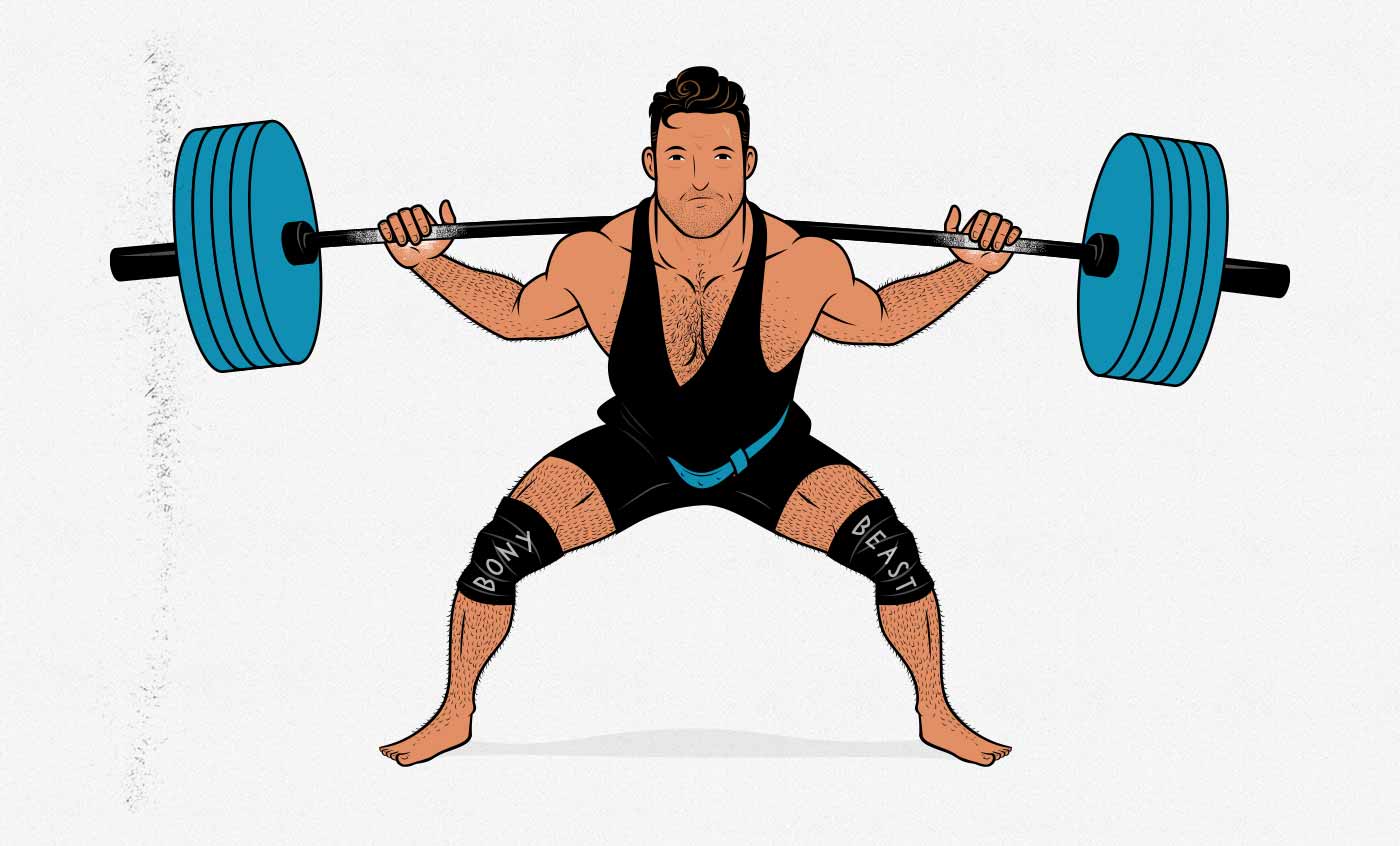
What is Strength Training?
There are a couple of different definitions of strength training:
- Strength training (aka lifting): Resistance training that uses progressive overload in order to build bigger, stronger muscles. This definition includes all types of lifting.
- Strength training (aka heavy lifting): Heavy lifting that’s done in low rep ranges (1–5 reps per set) in order to improve your 1-rep max strength on the big compound barbell lifts.
I’m going to use the second definition. That’s the type of strength training that’s often said to be best for gaining muscle size, so that’s what we’ll look into.
Here are some popular examples of strength training programs:
- Starting Strength: 5 reps per exercise, full-body workouts
- StrongLifts 5×5: 5 reps per exercise, full-body workouts
- Bigger, Leaner, Stronger: 4–6 reps per exercise, push/pull/legs split
Strength training programs often focus on the squat, deadlift, and bench press, but you can apply the principles to almost any lift. For example, it’s common to use strength training to gain strength at the overhead press and the barbell row. Most of them are fairly minimalist, though, with just 3–4 exercises per workout.
Strength training causes several structural adaptations, as most types of lifting do: your muscles will grow bigger, your tendons will get stronger, your bones will become denser. Many great adaptations take place. However, the main goal of strength training is to teach your neural system how to contract all of your muscle fibres at once for a single all-out rep, which has been nicknamed neural gains (study). This makes you stronger in a powerlifting sense.
So although strength training does stimulate some muscle growth, it’s best for making you stronger for your size.
What is Hypertrophy Training?
Hypertrophy training is simply training designed to make your muscles bigger (muscle hypertrophy). Some people use the term “bodybuilding” to mean the same thing. However, bodybuilding usually involves a focus on aesthetics and leanness as well as muscle size. Hypertrophy training is indeed what bodybuilders use to gain muscle size, but it can be used for all manner of goals:
- An athlete might do hypertrophy training to gain more muscle mass for his sport.
- A powerlifter might alternate between hypertrophy training (to get bigger and stronger) and strength training (to get stronger for his size).
- A skinny guy might bulk up with hypertrophy training because he wants to get bigger, stronger, and healthier.
- And of course, yeah, hypertrophy is also the best way to improve your appearance.
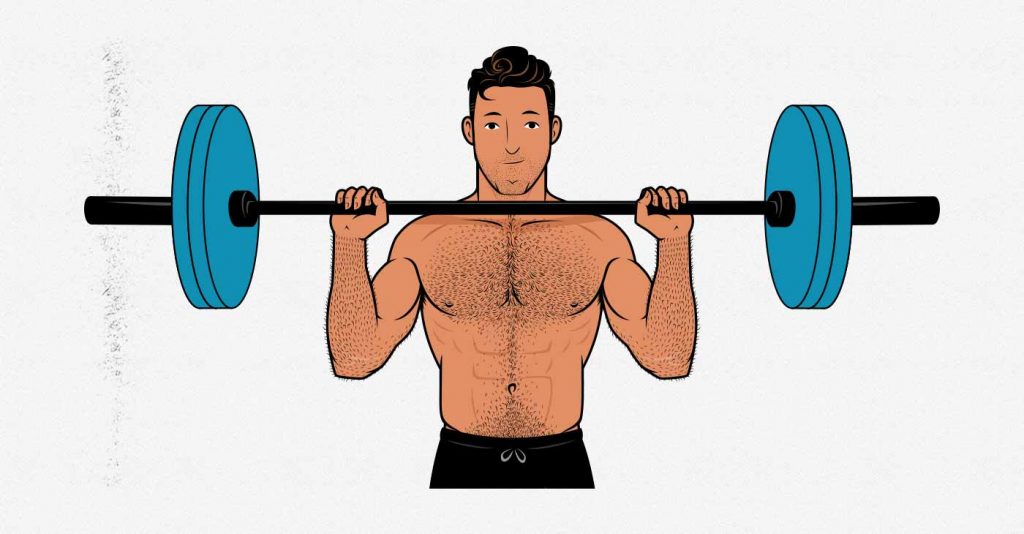
Hypertrophy training usually involves doing 6–12 reps per set, which causes your muscle fibres to adapt by becoming bigger. It’s quite common for hypertrophy programs to dip as low as 4 reps per set and fly as high as 20 reps per set, but the main emphasis tends to be in the “moderate” 6–12 rep range.
Hypertrophy training isn’t tied to any specific lifts, but the big compound lifts tend to be the best for gaining overall muscle mass: squats, deadlifts, bench press, chin-ups, rows, push presses, and so on. In addition to the big compound lifts, hypertrophy programs will often have smaller isolation lifts, such as bicep curls and lateral raises.
A bigger muscle is a stronger one, so hypertrophy training will absolutely make you stronger. However, it’s not going to teach you how to contract all of your muscle fibres in unison for a single all-out repetition. It’s not specialized for lifting 1-rep maxes. That’s why powerlifters will do hypertrophy training to gain size, then switch to strength training a couple of months before their competition to specialize their muscles for lifting heavy singles.
Hypertrophy training is best for making you bigger and stronger.
Which Rep Range is Best for Building Muscle?
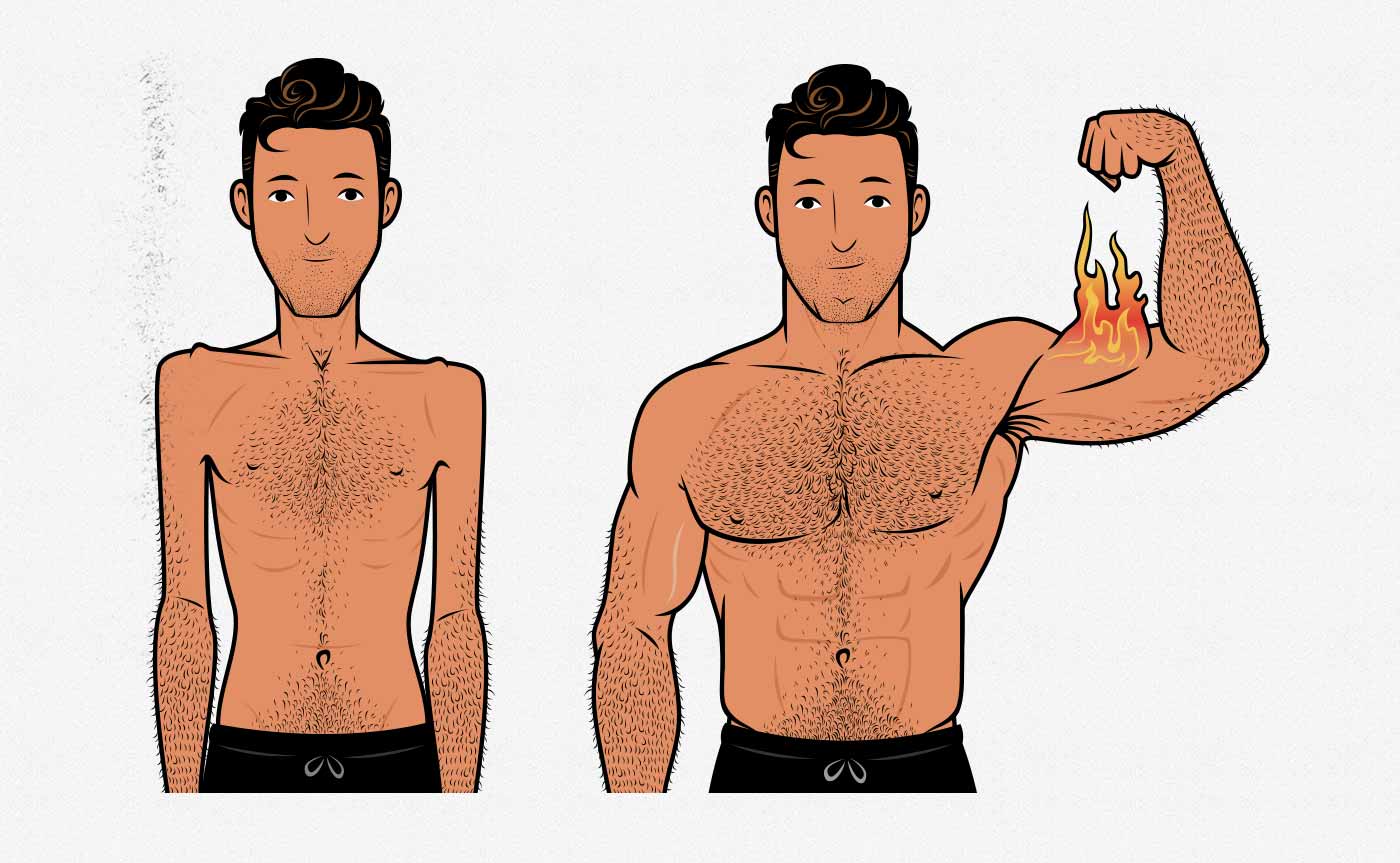
Low-rep strength training is designed to help people gain maximal strength, whereas moderate-rep hypertrophy training is designed to help people gain as much muscle size as possible. The bigger a muscle gets, the stronger it becomes, so there’s quite a lot of overlap between these two styles of training. Even so, lower reps tend to make us stronger for our size, whereas moderate reps tend to make us bigger and stronger.
For the first example, in an 8-week study by Brad Schoenfeld, PhD, his researchers split the participants into two groups:
- The strength training group did 2–4 reps per set. They saw a 30% increase in squat 1-rep max, with a 4% increase in quad size.
- Hypertrophy training group did 8–12 reps per set. They saw a 17% increase in squat 1-rep max, with a 10% increase in quad size.
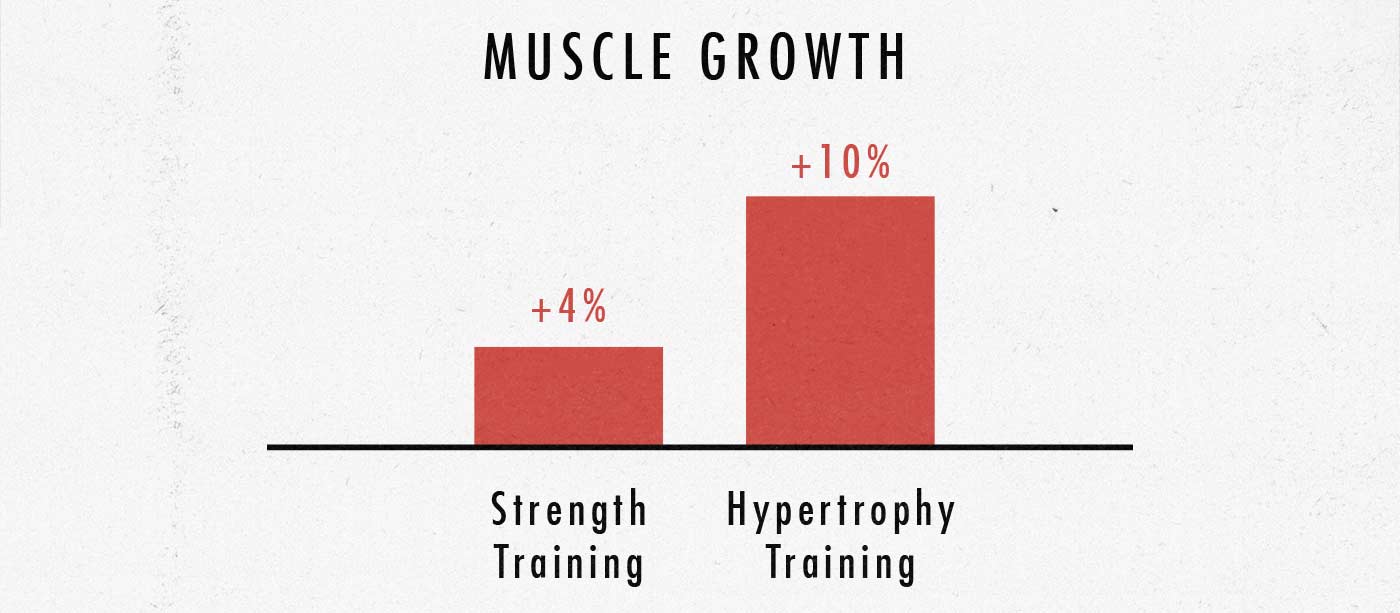
Both groups did the same exercises and the same number of sets, but the strength training group improved their 1-rep max by twice as much, whereas the hypertrophy group gained twice as much muscle size.
How was the strength training group able to gain so much strength without a proportional increase in muscle size? They were becoming more efficient with the muscle mass they already had. They were getting better at contracting more muscle fibres at once for an all-out single. They were making neural gains.
Why did the hypertrophy group gain so much muscle size without gaining strength? The hypertrophy gained more than twice as much muscle in their quads. However, because they weren’t lifting close to their 1-rep max, they never practiced contracting all of their muscle fibres simultaneously for a single all-out repetition. Their bigger muscles had more strength potential, they just hadn’t had as much practise lifting heavy.
Now, to be fair, there are other studies showing that strength training produces more muscle growth than hypertrophy training. For example, a two-week study conducted by Mangine et al found the opposite results:
- The strength training group did 3–5 reps per set, rested 3 minutes between sets, and gained twice as much arm size.
- The hypertrophy training group did 10–12 reps per set and rested 1 minute between sets, and only got half the arm growth.
This is the problem with using just a single study to prove a point. Sometimes studies produce outlier results, and sometimes it’s hard to explain the divergent findings. Sometimes it’s hard to even tell which study is the outlier.
The next question is: what could explain the differences in the results of these two studies? I think it could be the rest time between sets. Rest times shorter than two minutes reduce muscle growth (study), so the difference in muscle growth could have less do with the reps per set, more to do with the shorter rest times.
Fortunately, we have a systematic review of fourteen studies comparing how different rep ranges affect muscle growth. It found that strength training stimulates about half as much muscle growth as hypertrophy training per set, with 6–20 reps being ideal for gaining muscle size.
We also have Dr Stuart Phillips’ research showing that hypertrophy training stimulates more muscle protein synthesis than strength training. This explains how over time, hypertrophy training would yield more muscle growth than strength training.
Greg Nuckols, MA, also reviewed all of the research comparing strength training and hypertrophy training. He found that hypertrophy training produces 10–15% more muscle growth than strength training, which still gives hypertrophy training the advantage, albeit a much smaller one. He suspects that sets ranging from 4–40 reps stimulate similar amounts of muscle growth. He still recommends focusing on hypertrophy training for gaining muscle size, as well as recommending that powerlifters spend more of time training like bodybuilders. However, this has more to do with hypertrophy training allowing people to handle more hard work per workout and per week, as we’ll discuss below.
Most recently, a 2020 study compared groups doing 4-rep, 8-rep and 12-rep sets. The 4-rep group did seven sets, the 8-rep group did four sets, and the 12-rep group did three sets. All groups saw equal muscle growth. Now, it’s unclear how much muscle growth the 4-rep and 8-rep groups would have gotten if they had just done three sets—it’s possible that doing more then three sets simply creates diminishing returns—but this study still shows that doing just three 12-rep sets produces as much muscle growth as doing seven 4-rep sets.
Why isn’t Strength Training Best for Gaining Size?
The next question is why hypertrophy training produces more muscle growth than strength training. The main thing that causes muscles to grow is mechanical tension, so you’d think that loading up a muscle with the heaviest loads would stimulate the most growth. However, that’s not what we see.
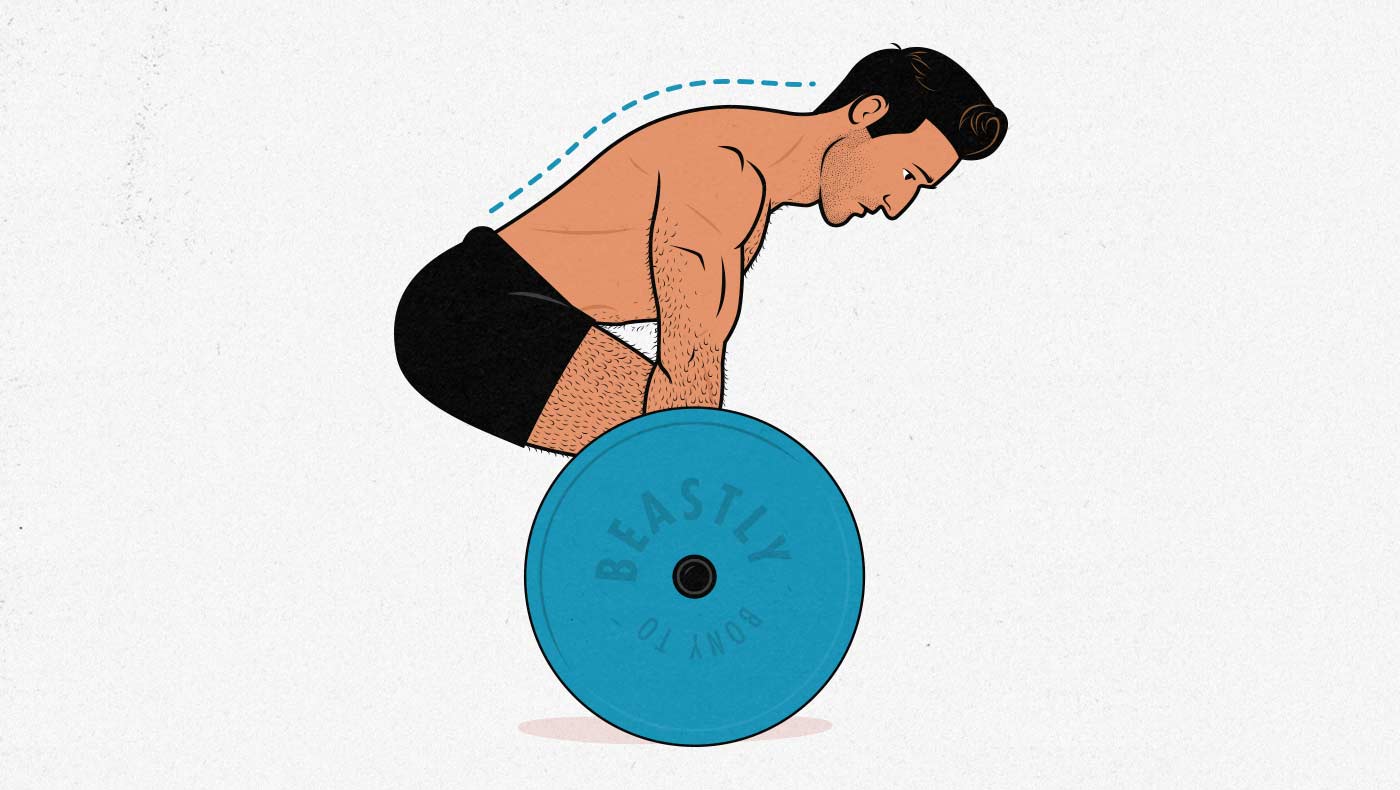
One likely explanation is that hypertrophy training is done with a higher volume. That doesn’t necessarily mean doing more sets, it just means that more total weight will be lifted per workout. For example, if your 1-rep max on the bench press is 225 pounds:
- Strength training: 185 pounds × 5 reps × 5 sets = 4625 pounds lifted
- Hypertrophy training: 160 pounds × 10 reps × 5 sets = 8000 pounds lifted
This means that in the above studies comparing strength and hypertrophy training, where the total number of sets was equated, the hypertrophy group was lifting with a substantially greater volume. Perhaps simply lifting more weight per workout is what’s most important.
The benefits of lifting with a higher volume go beyond the obvious, too. By increasing our lifting volume, we’ll not only adapt by building bigger muscles, but we’ll also adapt by improving our work capacity. Our muscles will develop the capacity to lift a greater overall poundage per week. This is an incredibly important aspect of our fitness. Not only is it practical, but it’s also healthy, and it even improves our ability to build muscle. (This is a topic for another article, though. In the meantime, our article about cardio might help.)
To directly test the hypothesis that the extra lifting volume was responsible for the extra muscle growth, Schoenfeld conducted a study where he matched the volume between the strength and hypertrophy groups:
- The strength training group did 7 sets of 3 repetitions. It took them 70 minutes to finish their workouts, and by the end of the study, they were complaining of sore joints and overall fatigue. 2 participants dropped out due to joint pain.
- The hypertrophy training group did 3 sets of 10 repetitions. It took them 17 minutes to finish their workouts, they were eager to do more lifting, and they finished the study feeling fresh.
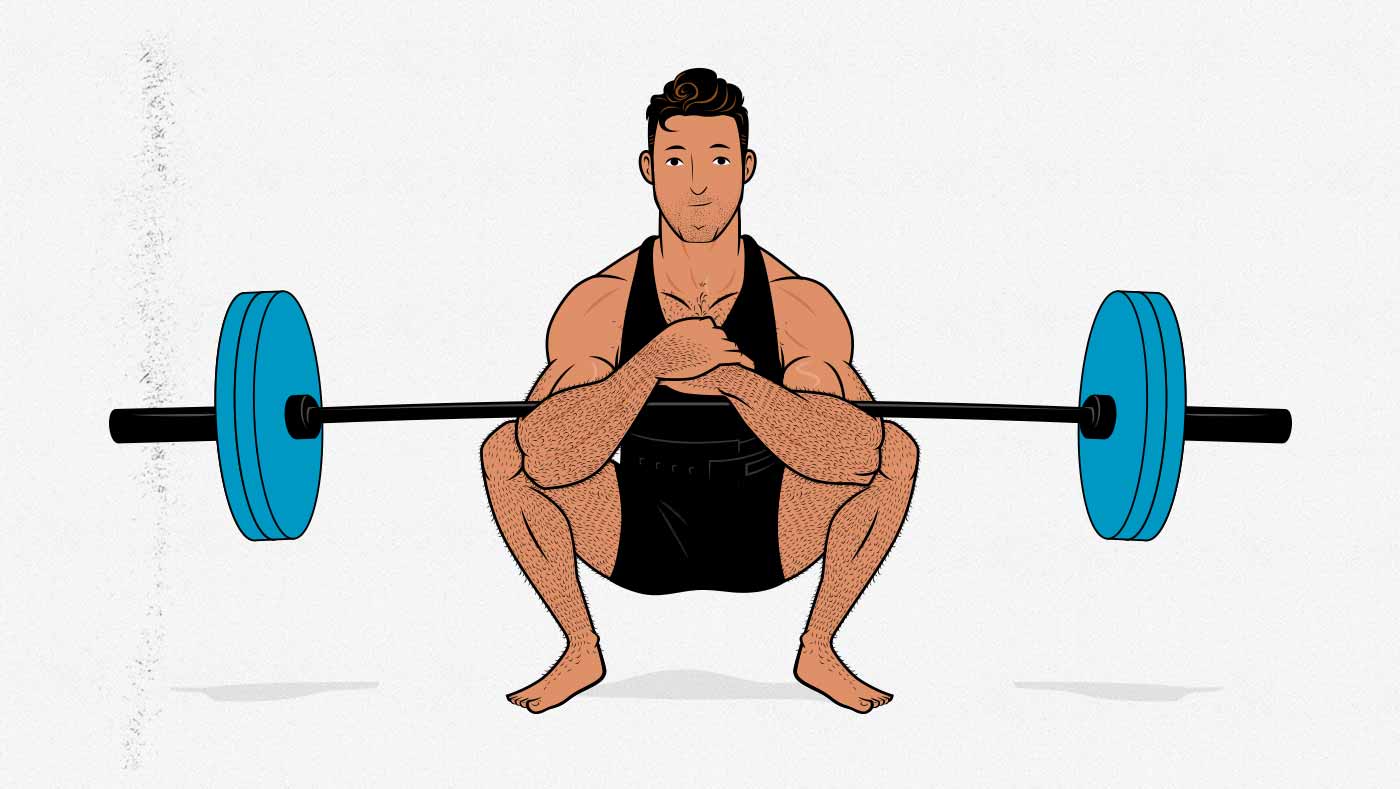
Both groups gained the same amount of muscle size, suggesting that volume was indeed the main driver of muscle growth. However, it’s a bit of a false comparison. Schoenfeld remarked that the hypertrophy training group could easily have thrown in some biceps curls, lateral raises, and some other isolation exercises to boost muscle growth without needing much extra time or imposing much extra stress on their joints.
If both groups were given 70 minutes to train each workout, the hypertrophy group would have been able to achieve a much higher lifting volume, would have netted a ton of extra benefits, and would have gained much more muscle mass.
This is likely why hypertrophy programs are able to produce so much more muscle growth than strength training programs. It’s not just that hypertrophy training seems to produce slightly more growth per set, it’s that it allows people to do more lifting in less time and while accumulating less fatigue.
This advice lines up with how most hypertrophy training programs are structured. You start with the heaviest compound lifts (chin-ups, squats, deadlifts). Then progress to moderately heavy compound lifts (overhead presses, bench presses, rows). And then finish the workouts with some lighter accessory lifts for your abs, your arms, your shoulders, your chest, and your upper back.
Sarcoplasmic Versus Myofibrillar Hypertrophy
The next thing to consider is whether strength training causes a different kind of muscle growth. For example, it’s often claimed that strength training stimulates myofibrillar hypertrophy (growth in the part of the muscle fibre that can produce force), which creates stronger muscles. Hypertrophy training, on the other hand, is said to cause sarcoplasmic hypertrophy (more fuel in the muscle fibres), which builds muscles with greater work capacity. Is that true?
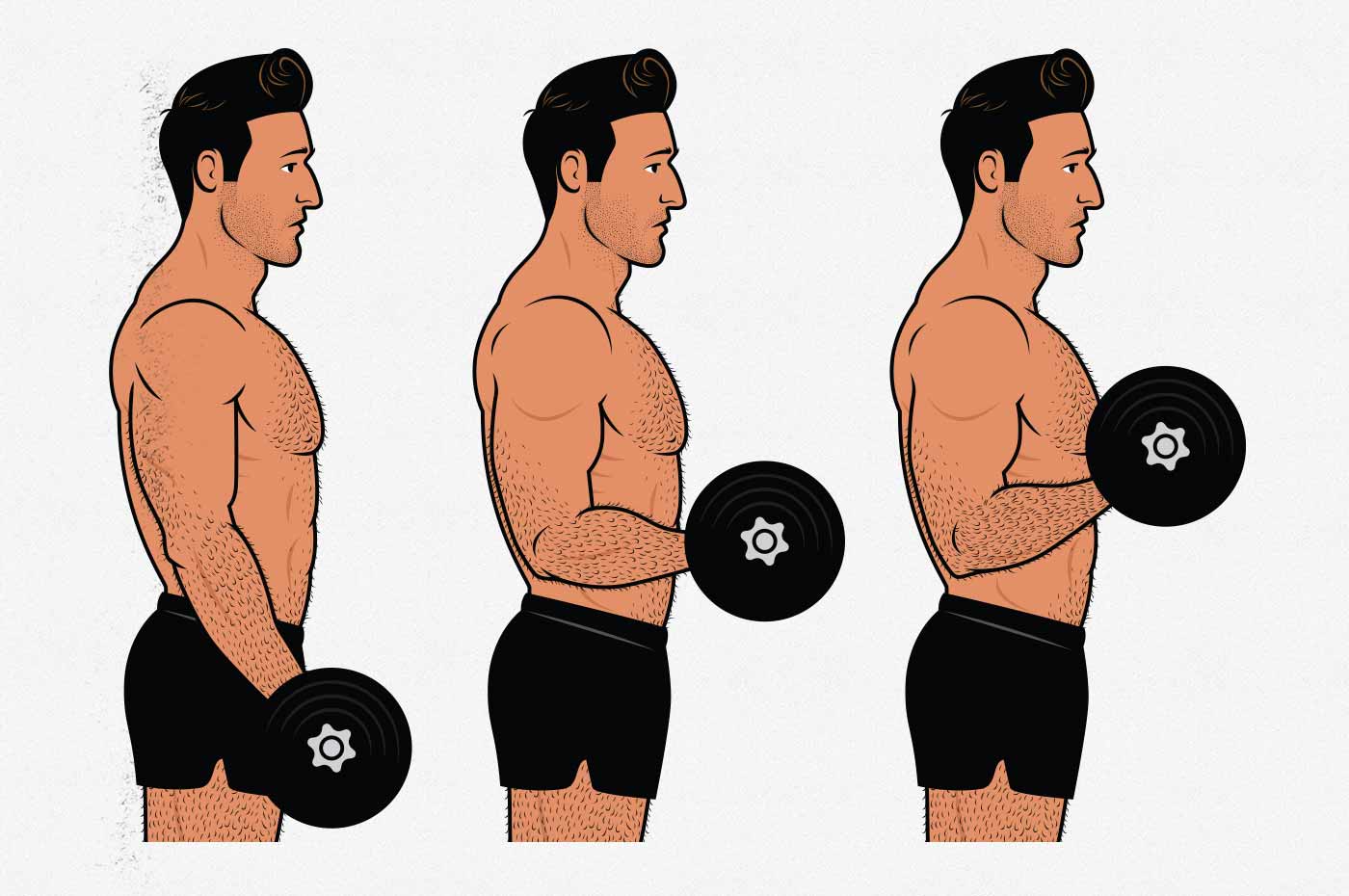
There’s not a lot of research looking into sarcoplasmic versus myofibrillar hypertrophy, but it seems logical that training in moderate rep ranges would require more anaerobic fuel, and thus hypertrophy training would stimulate sarcoplasmic muscle growth. There’s a brand new study that supports this idea.
Conversely, if you’re training your muscles to be strong for a single repetition, then what you need is more force production, and so strength training would stimulate myofibrillar muscle growth. There’s a study that supports this idea as well.
However, this study found that well-trained bodybuilders and powerlifters both have proportionally high sarcoplasmic hypertrophy when compared to smaller, weaker lifters (meta-analysis).
This could be because most successful powerlifters will use hypertrophy training to bulk up close to their genetic potential (to get bigger and stronger). Then, once they’ve gained as much muscle as their frame can support, they’ll focus more exclusively on strength training (to become bigger for their size). So even with well-trained powerlifters, it could still be the hypertrophy training that’s causing the sarcoplasmic hypertrophy.
It also seems like strength and hypertrophy training may both cause equal amounts of myofibrillar hypertrophy, but then hypertrophy adds extra sarcoplasmic hypertrophy on top of that, which is where all of the extra muscle growth comes from. This lines up with the research showing that higher training volumes stimulate more muscle growth. Higher training volumes, whether coming from strength or hypertrophy training, require more fuel, and so they stimulate that extra sarcoplasmic hypertrophy.
Again, this all lines up with the idea that strength training making guys bigger for their size, whereas hypertrophy training making people bigger and stronger.
Does Strength Training Build Denser Muscles?
Both strength training and hypertrophy training seem to produce the same amount of myofibrillar hypertrophy. It’s just that hypertrophy training seems to add in extra sarcoplasmic hypertrophy.
Judging by the names, you’d think that myofibrils were a hard structural addition, whereas the sarcoplasm was the fluid part. That would lend credence to the idea that myofibrillar hypertrophy creates harder muscles. It’s not a totally crazy idea.
It’s not quite that simple, though. Whether you’re adding myofibrils or sarcoplasm, most of the extra muscle mass is coming from added water. And that extra mass is going inside your muscle fibres. In either case, your muscle fibres are getting bigger and that size is coming primarily from the added fluid.
When you pack more water into your muscle fibres along with the new tissue, they look bigger and harder and denser. They also function better.
Is there a reason to think that a muscle with proportionally more sarcoplasm is going to look or feel any different? No. Mind you, there’s no research about it, either. It seems like the idea was invented to market a certain strength training program and then got spread around, never being based on anything.
Both myofibrillar and sarcoplasmic muscle growth is perfectly functional. In either case, the extra fluid is there for good reason.
Fast-Twitch Versus Slow-Twitch Muscle Growth
Up until recently, many researchers speculated that heavier strength training would do a better job of bulking up our fast-twitch muscle fibres, whereas higher-rep bodybuilding would do a better job of bulking up our slow-twitch muscle fibres.
However, a 2020 study conducted by Dr Schoenfeld found that whether we train with low, moderate, or high-rep sets, it doesn’t have much of an impact on how much muscle we build or in which muscle fibre type gets that growth.
So, as the research currently stands, it seems like we can bulk up our bigger fast-twitch muscle fibres just as well with moderate and high-rep training. There’s a fairly good explanation for this, too. Mechanical tension is the main driver of muscle growth in both our fast-twitch and slow-twitch muscle fibres, and so we can build muscle either by increasing the magnitude or duration of the tension. If we lift heavier weights for fewer reps, the magnitude is higher but the duration is lower, and vice versa.
This explanation also hints at why very-low-rep sets don’t produce much muscle growth per set—because the slightly higher magnitude of the mechanical tension is dwarfed by the much higher duration of higher-rep sets.
Is Strength Training More Functional?
Finally, there’s the idea that strength training makes guys small but strong, whereas bodybuilding makes guys big but weak. This implies that if you care about more than simply gaining muscle size, strength training is the better approach. Is this true?
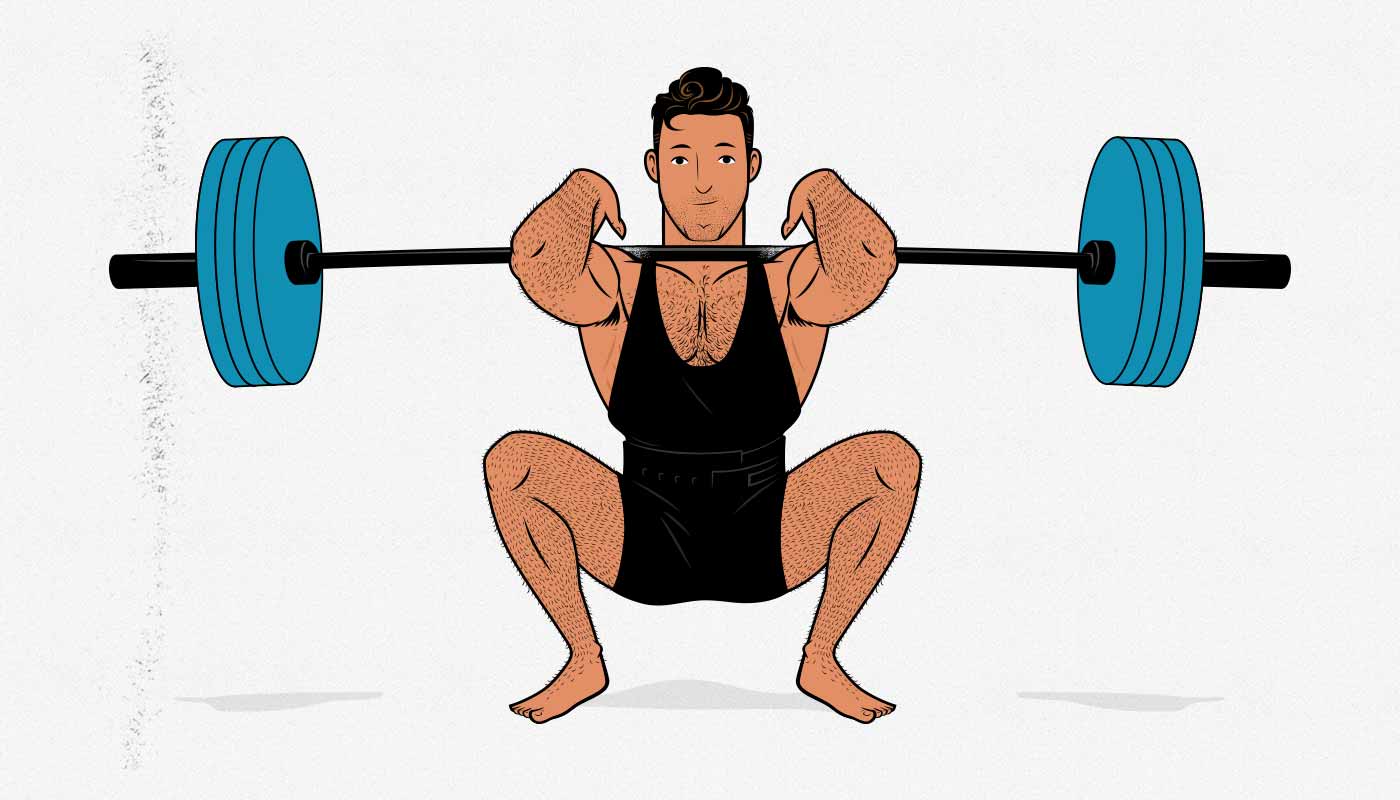
The first thing to point out is that a bigger muscle is a stronger one. For example, this study shows that bench press strength is directly correlated with the amount of muscle someone has in their chest, arms, and shoulders. There’s no way for a muscle to get bigger without it getting stronger and more functional.
Some guys are stronger than others because their proportions or muscle insertions give them better leverage. For example, a guy who’s built like a gorilla will be great at the deadlift but poor at the bench press. Conversely, a guy who’s built like a crocodile will be terrible at the deadlift but great at the bench press. But that has nothing to do with training styles or muscle size, just genetics.
The reason bodybuilding can make guys big but weak has to do with exercise selection. For example, let’s say that the leg press is a popular bodybuilding exercise, whereas the back squat is a popular strength training exercise. Both exercises will build bigger and stronger leg muscles, but only the squat will build up the spinal erectors.
This means that the bodybuilder will have big strong leg muscles, but because he lacks size and strength in his spinal erectors, he won’t be able to carry heavy things.
Of course, if the bodybuilder trained with different exercises, that problem would disappear.
Besides, if we’re talking about strength training versus hypertrophy training, then we’re not talking about exercise selection, we’re just talking about rep ranges and training volume. In this case, we’d be comparing:
- Strength training: squatting for 5 sets of 3 repetitions
- Hypertrophy training: squatting for 4 sets of 8 repetitions
In this case, both guys will be training their legs along with the hundreds of supporting muscles, including their spinal erectors. Both guys will have fully capable bodies, but the hypertrophy training will yield more muscle size and better strength endurance, whereas the strength training will yield more neural gains and a stronger 1-rep max.
If you want a strong and functional body, whether you’re doing strength or hypertrophy training, it’s best to focus on doing the big compound lifts that develop strength from head to toe:
- The Deadlift (especially the conventional deadlift)
- The Squat (and especially the front squat)
- The Chin-Up
- The Bench Press
- The Overhead Press
This doesn’t mean that smaller exercises are less functional, though. For example, a barbell curl is a great exercise for building bigger, stronger, and more capable elbow flexors (biceps, brachialis, brachioradialis) as well as building up stabilizer strength in your upper back. Even smaller lifts make us more capable, they just don’t train as many muscle groups at once.
The Big Three Powerlifting Lifts Aren’t Ideal for Bulking
Powerlifting isn’t designed to help people get bigger and stronger, it’s a competition to see who can lift the most weight for a single repetition on three arbitrary lifts. That’s not a knock against powerlifting, it’s just that powerlifting is too busy winning powerlifting competitions to care about building bigger biceps or broader shoulders.
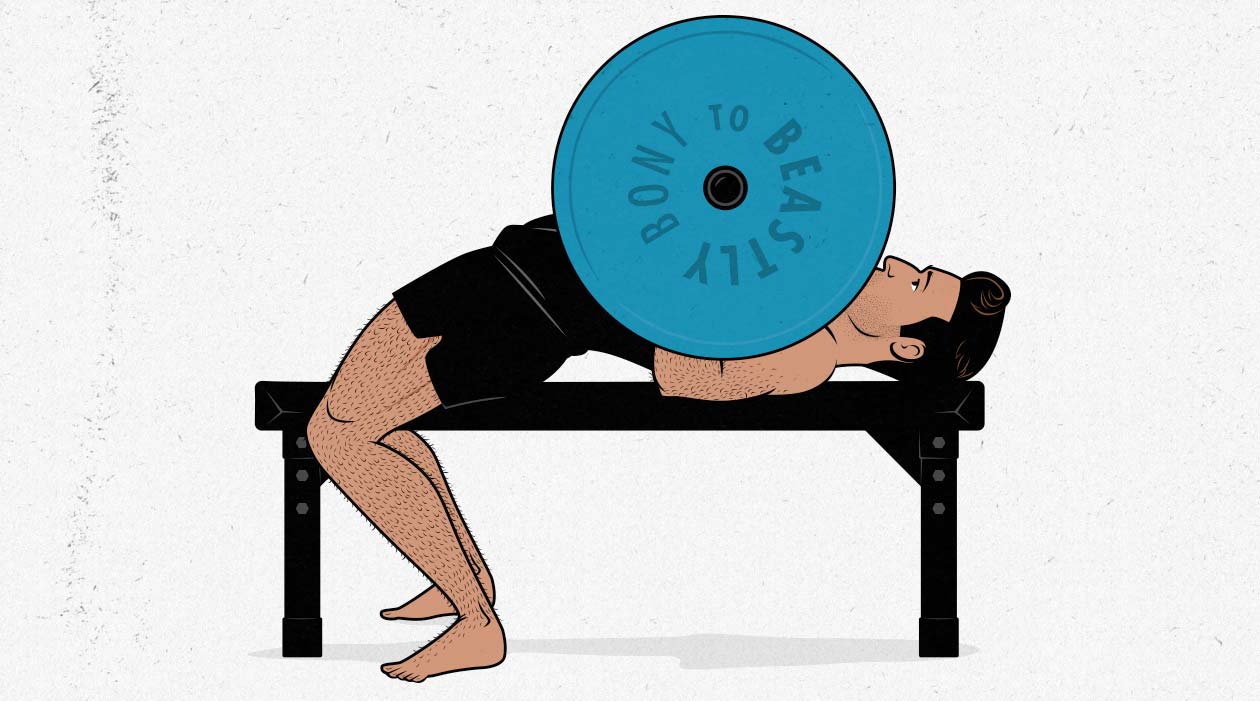
Now, to be clear, the powerlifting lifts aren’t bad for building muscle. In fact, they have a number of advantages:
- They challenge our muscles in a stretched position, which is great for stimulating muscle growth. The squat challenges our quads in a stretched position, the bench press challenges our chests and shoulders in a stretched position, and the deadlift challenges our glutes and hamstrings in a stretched position.
- They engage a lot of overall muscle mass, making them quite efficient. Of all the lifts, the squat and deadlift stimulate growth in the most overall muscle mass, making them great bulking lifts.
Even so, there are a few reasons why powerlifting is bad for bulking:
- Lifting technique is centred around lifting more weight, not building a better physique. For example, powerlifters choose a wide-stance low-bar barbell back squat not because it’s better for developing their physique, but because it allows them to load the barbell heavier. Better to pick a squat variation that develops more muscle size and strength.
- Range of motion is arbitrary. Some people can squat deep, others can’t. There are a variety of reasons for this, ranging from technique to strength to anatomy. In powerlifting, though, guys who can squat deep are incentivized to cut their range of motion short, missing out on the benefits of going deeper. Worse, the guys who can’t squat deep still need to hit depth, so they have to force it. Better to use a range of motion that suits you.
- The Big Three lifts themselves are arbitrary. The squat, deadlift, and bench press weren’t chosen as the powerlifting lifts because they were the best lifts for developing overall size and strength, they were chosen for the sake of the sport—because they were good for testing 1-rep maxes with precisely defined rules. For an idea of how arbitrary the lifts are, compare them against the lifts in a strongman competition. The two strength sports define strength with entirely different lifts.
- The rep ranges are too low for hypertrophy. powerlifters measures strength in terms of how much weight they can lift for a single repetition. And in order to develop that specialized 1-rep max strength, they need to spend a lot of time lifting in very low rep ranges (strength training). Lifting in low rep ranges will yield some muscle growth, sure, but it’s by no means ideal for building muscle. For most of us, it’s better to spend more of our time lifting in moderate rep ranges.
- There’s too little upper-body development. I’ll need to write a whole separate article about this, but the idea of building an aesthetic physique largely hinges on developing the type of strength that helped us survive as we evolved. It’s the type of strength that allows us to wrestle, fight, and wield weapons. You could certainly argue that we’ve evolved past needing that kind of strength, but that doesn’t change the fact that it’s the kind of strength that women find the most attractive and that other men consider the most impressive. (Oddly enough, leg size is largely irrelevant to aesthetics.)
- The Big Three lifts don’t bulk up our abs. Yes, the squat and deadlift will bulk up the transverse abdominis muscle, which is a corset-like muscle that helps to keep the core locked doing while doing compound lifts. However, when most of us think of our “abs,” we’re thinking of our rectus abdominis muscles—the 6-pack ab muscles. Squats and deadlift don’t stimulate those ab muscles. So if you have skinny abs that you’re trying to bulk up, you’ll need lifts that actually train your abs.
Powerlifters are absolutely brilliant at developing killer strength, it’s just not quite the kind of strength that will help us become bigger and stronger overall. It’s also not ideal for avoiding injuries, improving our appearance, or improving our general health.
Does This Mean That We Should Never Lift Heavy?
If your goal is to gain muscle size, definitely prioritize hypertrophy training. It will allow you to build muscle more quickly, more leanly, and more easily. However, that doesn’t mean you should only be doing hypertrophy training.
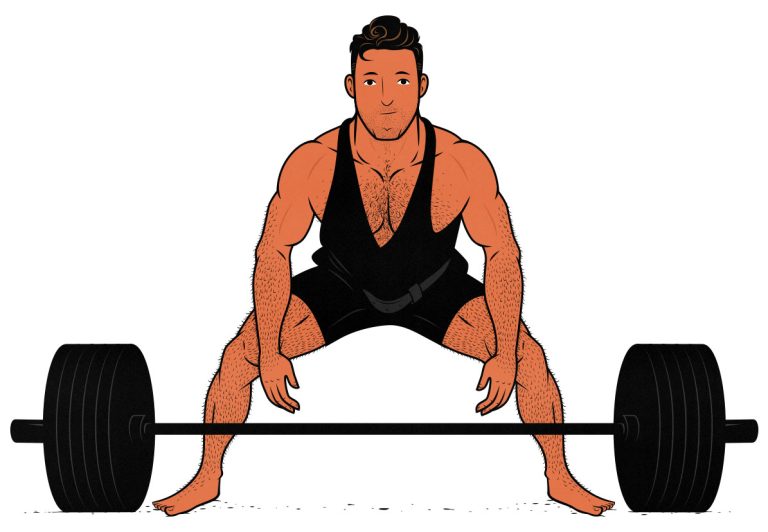
When Brad Schoenfeld, a leading hypertrophy expert, published his study showing that hypertrophy training was better for gaining muscle size, he wrote:
The study indicates that the best approach to building muscle is to perform a combination of heavy and moderately heavy loads. The ‘hypertrophy range’ is applicable from the standpoint that it allows the performance of a greater amount of volume without overtaxing the body’s resources.
What’s interesting is that even if your main goal is to gain strength, a mixed approach still seems to be best. When it comes to gaining strength, Greg Nuckols, a leading strength expert, writes:
If you focus on growth, the strength will take care of itself, provided you train with heavy loads occasionally, especially leading up to [powerlifting] meets. If you focus purely on heavy strength work while neglecting the volume necessary to maximize hypertrophy, you’re limiting yourself in the long run. The bulk of your time in the gym should be focused on growth, at least until you’re nearing your muscular potential.
So even though you’ll probably benefit from spending, say, 2/3 of your time lifting in the hypertrophy range, that still leaves 1/3 of your time for lifting heavier (and lighter). That way you’ll still be prioritizing muscle growth, but you’ll also be getting some of the benefits of lifting in other rep ranges.
Moreover, due to a phenomenon called the repeated bout effect (RBE), muscles grow best when you vary the stimulus. As you adapt to a specific style of training, your muscles will gradually grow more and more resistant to it, and your results will gradually slow. By adding in some heavier and lighter training, you’ll be able to ward off those plateaus.
Instead of doing a 5×5 bench press routine month after month, try some sets of 8, 10, and 12. By that same token, you’ll probably want to use a variety of different lifts for your chest, switching between them over time.
Key Takeaways
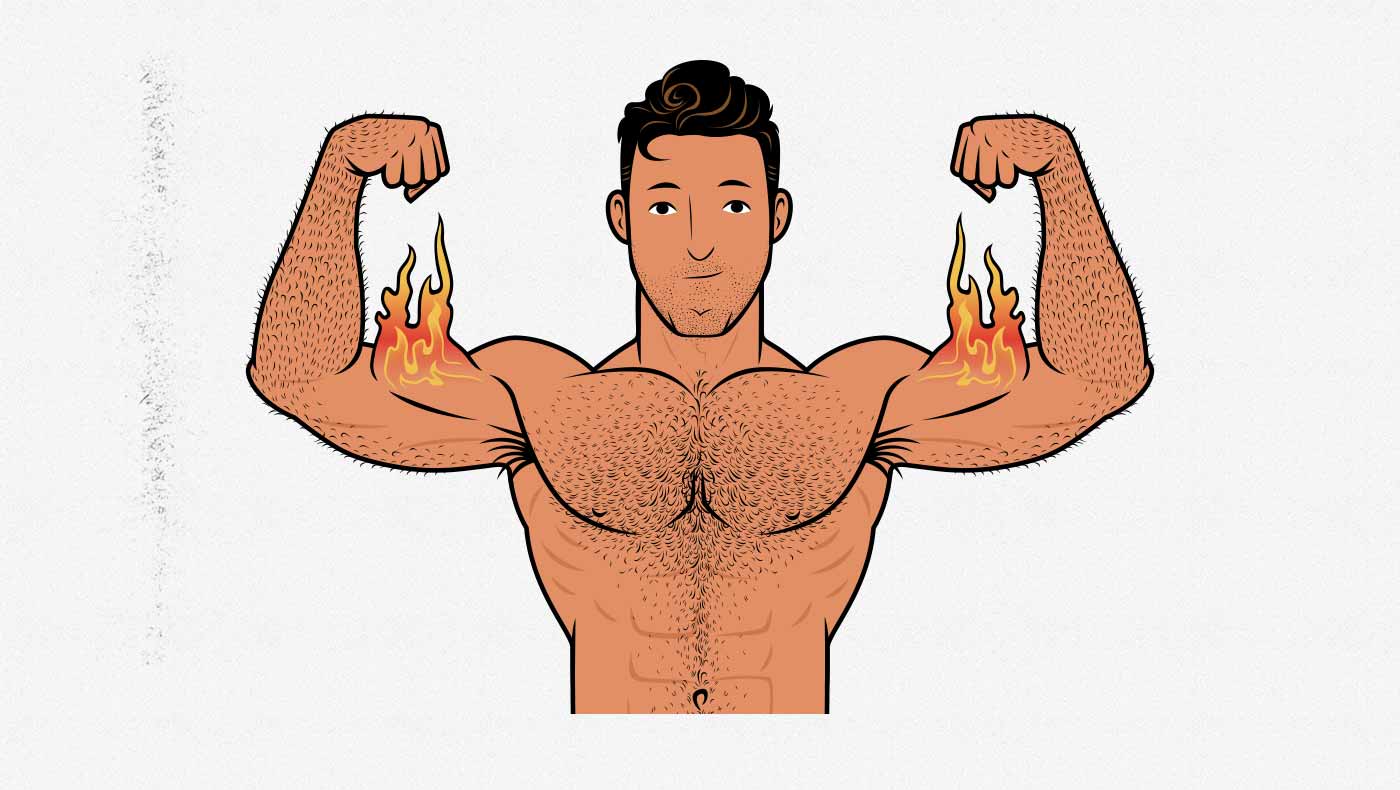
Strength training is good for gaining muscle when compared against many other types of exercise, such as Olympic weightlifting, bodyweight circuits, and CrossFit. When strength training is compared to hypertrophy training, though, it isn’t nearly as good for gaining muscle size. There are a few reasons for that:
- The most efficient rep range for building muscle is around 6–20 reps, with anywhere from 4–40 reps being effective. Strength training prioritizes the very low end of that range, which isn’t all that great for building muscle.
- The big three powerlifting lifts—the squat, the bench press, and the deadlift—are great lifts, but there are others that deserve equal attention.
- If we’re training for muscle size, we don’t want to lift like powerlifters. For example, front squats are often better than back squats, shallower arches tend to be better when benching, and we want to lower the weight more slowly when deadlifting.
- Isolation lifts are incredibly powerful for gaining muscle size. Without them, our arms will usually lag behind (and sometimes other muscles, such as our chests).
- Some muscle groups aren’t trained at all with strength training, such as our necks and biceps. Our forearms aren’t trained very well either, especially because grip strength doesn’t do much to increase the size of our forearms.
- Both sarcoplasmic hypertrophy and myofibrillar hypertrophy are functional, useful adaptations, and there’s no reason to believe that getting more of one kind of hypertrophy than the other would change the way our muscles look or feel.
If your main goal is to gain muscle size, hypertrophy training is quite a bit better for that specific goal. And of course it is—that’s what it’s designed for.

